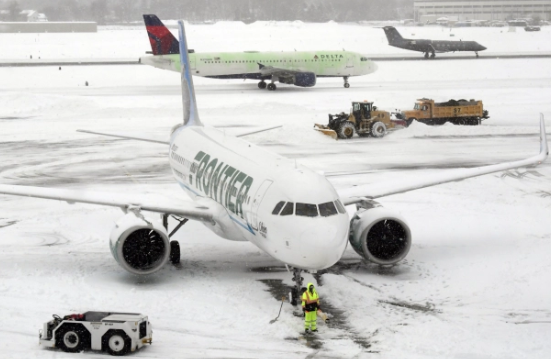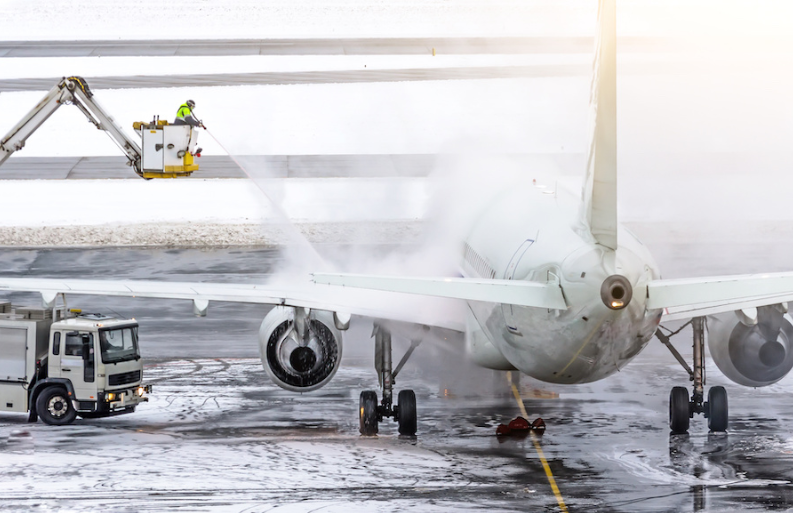Ever looked out your window on a frosty morning to find a blanket of white covering the ground and immediately thought, “Will my flight get cancelled?” It’s a common worry for travelers during the winter season. While snow may paint a scenic picture, it’s not necessarily a best friend for aviation. But how much snow exactly causes flight cancellations? Let’s delve into the fascinating world of “How Many Inches of Snow Will Cancel a Flight?”.
What Is the Minimum Snowfall Amount That Can Lead to Flight Cancellations?

The idea of a specific “magic number” of inches of snow that will cancel a flight is not as straightforward as it might seem. It’s important to understand that snow isn’t the only factor in the equation. Variables like temperature, the rate of snowfall, wind speeds, and more play a significant role in determining flight cancellation criteria for snow. That said, some experts suggest that around 3-4 inches of snow per hour is a crucial limit where operations start to become particularly challenging.
At What Snow Depth Are Flights Usually Canceled?

While 3-4 inches of snow per hour is a threshold that can impact flight operations, it doesn’t automatically mean your flight will be canceled. This is because airports are well equipped with snow removal teams and equipment designed to keep runways clear. If snow is falling at a rate that these teams can manage, flights may proceed as planned. However, in extreme scenarios where snowfall is too heavy to be managed efficiently, or accumulates too quickly, cancellations may become necessary.
How Much Snow Accumulation Causes Flight Disruptions?
Understanding the impact of snow accumulation flight cancellation policies involves a look at both the immediate and long-term effects of snow on aviation. Immediate disruptions may occur if snowfall rates exceed the capacity for runway clearing. Long-term disruptions can occur if accumulated snow exceeds the airport’s ability to store it safely away from operational areas.
What Are the Criteria for Canceling Flights Due to Snow?
Flight cancellations due to snow are based on safety considerations. Factors such as the aircraft’s ability to land and take-off safely, the effectiveness of de-icing procedures, and runway conditions are all considered. Even a small amount of snow can create slick conditions that may affect an aircraft’s ability to brake effectively.
How Does an Airport Decide to Cancel Flights During a Snowstorm?
A snowstorm can significantly impact flight operations. Airports closely monitor weather forecasts and make decisions based on anticipated conditions. If a snowstorm is forecasted to bring heavy snow, gusting winds, and low visibility, airport management may decide to proactively cancel flights to ensure the safety of passengers and crew.
Are There Different Snowfall Thresholds for Different Types of Aircraft?
Different types of aircraft indeed have varying capabilities when it comes to handling snow and icy conditions. Larger aircraft may be equipped with more advanced de-icing systems, while smaller planes may be more susceptible to icing issues. Each airline and type of aircraft has its own operating standards that must be adhered to, which can affect their tolerance to snowfall and ice.
What Measures Are Taken to De-ice Planes During Snowy Conditions?
In snowy conditions, de-icing procedures are key to safe flight operations. De-icing involves removing snow and ice from an aircraft before take-off. This process may involve using heated, glycol-based fluids and specialized equipment to ensure that the aircraft is free of ice and snow that could affect its performance.
How Do Airlines and Airports Handle Passenger Rebooking During Snow-Related Flight Cancellations?
In the event of a snow-related flight cancellation, airlines usually offer passengers the option to rebook on the next available flight without additional charges. Some airlines may also offer refunds or vouchers for future travel. It’s important to check with your airline for their specific policies.
Can Flights Be Delayed or Canceled Even if There Is No Snowfall at the Airport?
Indeed, flights can be delayed or canceled even if there’s no snowfall at the departure airport. This can occur if the destination airport is experiencing heavy snowfall, or if the flight path encounters a severe winter storm.
Are There Any Exceptions to Flight Cancellations During Heavy Snowfall?
Some airports, particularly those in regions accustomed to heavy snowfall, are particularly well-equipped to handle snow. They have robust snow removal operations and de-icing procedures. However, even these airports can reach a breaking point in truly extreme conditions. Safety is always the top priority in aviation, and no risks will be taken in hazardous conditions.
To wrap it up, it’s important to remember that the number of inches of snow required to cancel a flight isn’t a hard and fast rule. Instead, it depends on a multitude of factors. So, the next time you find yourself wondering about how the winter weather will affect your travel plans, consider this expert information. Safe and happy travels!
How Airport Operations Adapt to Snow Conditions
Having delved into the snowfall limits for flight cancellations, let’s now explore how airports manage during these frosty conditions. After all, aviation does not come to a standstill every time the snow begins to fall.
The Power of Snow Removal Teams
An essential line of defense against snowfall are the airports’ snow removal teams. When snow begins to accumulate, these dedicated teams spring into action, working around the clock to keep runways, taxiways, and airplane gates clear. Using specialized equipment such as snowplows, snow blowers, brooms, and de-icing trucks, they ensure that airport operations can continue safely.
The Science Behind De-Icing
The de-icing process is crucial to flight safety during winter months. In simple terms, it involves the removal of ice and snow from the aircraft. But it’s not just about making the plane look good. Ice and snow on an airplane can affect the aircraft’s aerodynamics, making takeoff unsafe.
De-icing is generally done using a heated mixture of propylene or ethylene glycol and water. This de-icing fluid, which is typically orange or pink to distinguish it from other fluids, is heated and sprayed under pressure to remove ice and snow from the aircraft.
Anti-Icing for Safe Flights
After the de-icing process is complete, an anti-icing fluid may be applied. This fluid is designed to prevent further accumulation of ice or snow on the aircraft as it waits for takeoff. This second layer of protection is typically green and thicker than the de-icing fluid, helping to prevent ice from forming on the aircraft during flight.
Managing Snow at the Airport
When large amounts of snow fall at an airport, it’s not as simple as plowing it and leaving it piled at the side of the runways and taxiways. Large snow piles can obstruct the view for pilots and air traffic controllers, and pose a risk to airplanes during landing and takeoff. Snow must be moved to designated areas where it won’t interfere with airport operations.
How Air Traffic Control Adapts
In conditions of heavy snowfall, it’s not just the ground operations that need to adjust – air traffic control procedures must also be adapted. With lower visibility, additional spacing between aircraft is often required, which can result in a reduction of the airport’s flight handling capacity.
Severe Weather and Aviation Regulations
During severe weather events, the Federal Aviation Administration (FAA) can issue a Ground Delay Program or a Ground Stop. A Ground Delay Program is a traffic management procedure where flights are delayed at their departure airport in order to manage demand and capacity at their arrival airport. A Ground Stop, on the other hand, halts the departure of flights for a certain period of time. These measures are often used in anticipation of severe weather to manage traffic and maintain safety.
Proactive Measures Taken by Airlines
Airlines can take proactive steps to mitigate the impact of snow on their operations. This can include adjusting flight schedules, re-routing flights, and even offering passengers flexible rebooking options before the snow hits. This helps to minimize disruption for passengers and allows airlines to manage their operations more effectively.
Weather Forecasting in Aviation
Modern weather forecasting plays a significant role in flight operations during winter. Airlines and airports work closely with meteorologists to understand the upcoming weather conditions. This allows them to plan ahead and make informed decisions about flight operations.
Preparing Your Flight in Winter Conditions
As a passenger, while you cannot control the weather, you can control how you respond to it. Always check the weather conditions at your departure and arrival airports before your flight. Be sure to check your airline’s policy for weather disruptions and know your rights and options if your flight is delayed or canceled.
Also Read: What’s That Smell, Food, and Fitness Family [A Detailed Guide]
Final Words: In a World of Constant Communication
In today’s interconnected world, staying informed about your flight status has become easier than ever. Most airlines provide real-time updates on their websites and through mobile apps, and some even send notifications about significant changes.
In wrapping up this article, we aspire to have given you a comprehensive understanding of “How Many Inches of Snow Will Cancel a Flight?” and its implications, arming you with the knowledge necessary to navigate this area successfully.





